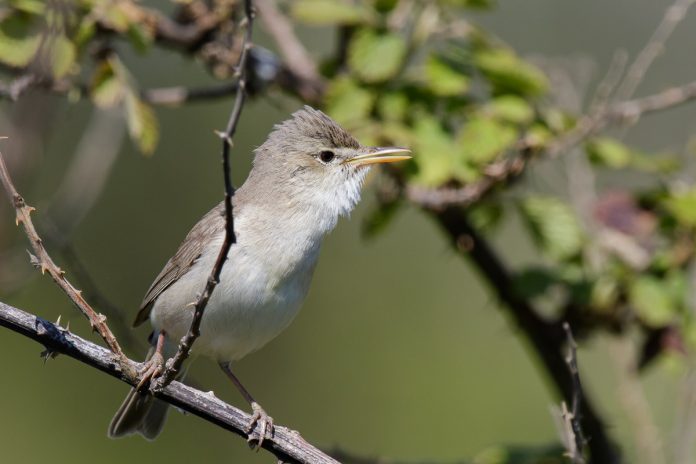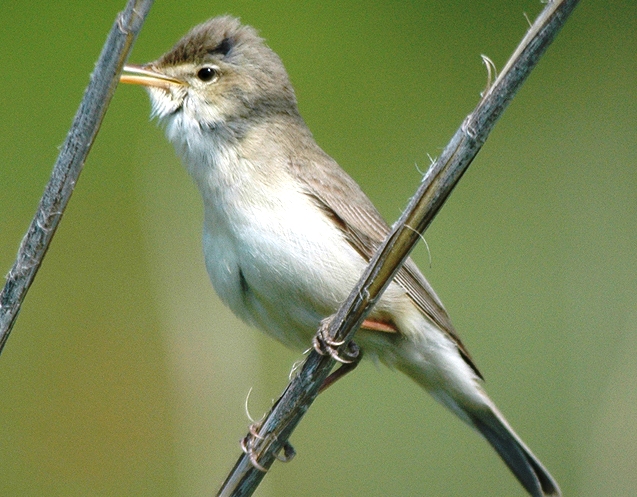The size of the Olivaceous warbler is about 12–13.5 cm in length. This bird is confusingly variable in size and shape, with smaller, shorter-billed birds resembling Booted and larger, strong-billed birds suggesting Upcher’s. Olivaceous Warbler is typically a medium-sized, rather long-bodied, fairly ‘washed-out’ mouse-brown warbler with paler, nearly whitish, underparts, no wing panel, and little or no contrast between the upper side of the tail and the rest of the upperparts.

Frequently a little warmer toned above in fresh autumn plumage, with buff tinge on flanks. The rather plain head pattern shows only a weak and narrow (but nonetheless clearly discernible) pale supercilium and sometimes a narrow darker shade through the eye (both features are higher up in front of the eye); the dark eye set in a paler loral area can be prominent and is sometimes the only readily apparent facial feature.
The head shape is usually sleek, with a comparatively flat crown and long pale bill (especially from below), but smaller races have relatively smaller bills. Legs are usually light brown or pinkish-brown, sometimes grayer. The tail is rather ‘loose’ and full, often appearing comparatively long when wings drooped; though virtually square-ended, it shows a little central notch and, under good viewing conditions, shows whitish outer webs to the outermost feathers, most noticeable towards the tip.
Hops slowly about in tree canopy and bushes with horizontal stance, moving rather ‘full’ tail slowly with downward flicking and waving, often pausing with tail held slightly upwards. Call distinctive. Though the small races of Olivaceous are easily perplexed with Booted, the latter has a shorter body, more rounded head shape, a finer and insignificant bill (with a darker culmen and smudge at the tip of the lower mandible), and a darker shade along the the crown sides.
This highlights the stronger supercilium; Booted often flicks tail upwards and has a slightly different call. Booted off the race rama (Sykes’s Warbler) are moderately longer-tailed and longer and broader-billed than the nominate race and make an impression more suggestive of Olivaceous, but exhibit similar differences in the head and bill patterns.
Thus, the larger races of Olivaceous, particularly in fresh plumage when pale edges to flight feathers are obvious, suggest Upcher’s, but the latter is grayer overall, has a stronger wing panel (in fresh plumage) and longer main projection, and has a broader and darker tail which contrasts with the rump and uppertail coverts.
The tail of Upcher’s is usually moved up and down and sideways with deliberate effort; the call is also stronger. Confusion is also possible with Blyth’s Reed Warbler, but the latter is darker, less grayish or mouse-brown, above and more buff below, with darker bill and legs, more pronounced head pattern, and more rounded tail. Blyth’s Reed also lacks whitish outer tail feathers, lacks ‘loose’ tail movements, and has quite an unusual call. Hence, to compare also Melodious, Marsh and eastern races of Bonelli’s Warblers.
The juveniles may be aged in autumn by fresh plumage, especially flight feathers, which are abraded in adults. Probably migrates in juvenile plumage, although this is not established for certain. In fresh plumage, a buff tone may be present on underparts and a hint of the olive may be discernible on the upper parts of northern populations.
The typical call of Olivaceous Warbler is a weak, soft ‘chuk’ or ‘tuk’, uttered intermittently as the bird moves about in trees and bushes. The bird also gives a sharp series of ticking notes and a harsh, churrring ‘trrrrrrr’ of alarm. The song of the Olivaceous Warbler is a rapid Acrocephalus-like chattering not unlike that of the European Reed Warbler, but faster, more chattering, and more monotonous, with a series of phrases regularly repeated; notes seemingly less different and ‘sliding’ into each other. The geographical variation marked variation in overall size and bill length for a warbler.

There are possibly five races (opaca, elaeica and reiseri illustrated). The Western race opaca of Iberia and NW Africa largest and with the longest and broadest bill. Though the least and most sandy populations occur in Saharan oases of southern Algeria (reiseri), Tibesti (laeneni), and Egypt (nominate race), with birds of Southeast Europe and eastwards (elaeica) rather intermediate in size and rather darker and greyer than small races.
The olivaceous Warbler is fairly a common bird over most of its range, but uncommon in the Iberian Peninsula. (In addition to mapped range, has bred Austria. They spend most of the winter in the south of the Sahara.) Therefore, all kinds of fairly open bushy habitats in dry country, frequently with scattered trees. It is also seen around olive groves, orchards, oases, parks, and gardens.
